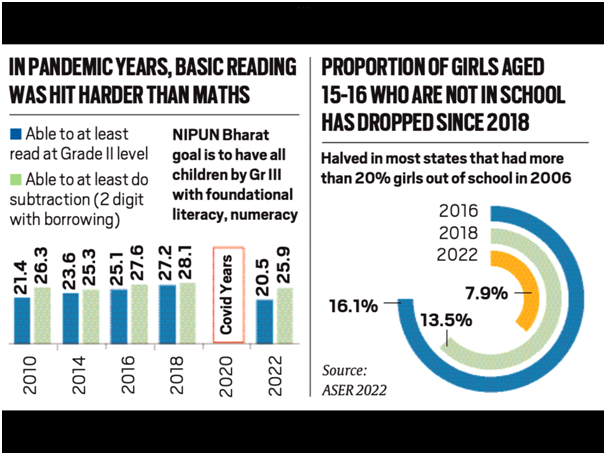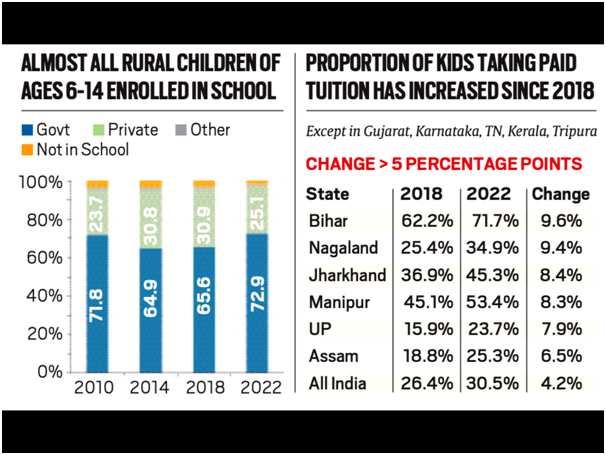ASER Survey
Context: ASERs survey children in the age group of 6 to 14 to record trends in school enrollment, attendance, and reading and arithmetic abilities since 2005.
More on the News
- Pratham’s Annual Survey of Education Report (ASER) 2022 is the first full-fledged survey after the pandemic.
- It points to a national level decline in school children’s basic reading ability besides a dip in arithmetic abilities, confirming the ‘learning loss’ believed to have set in amid school closures.
- The ASER 2022 report surveyed 99 lakh children aged between 3 to 16 across 616 rural districts.
Enrollment Data
- Despite the pandemic forced school closure, the figure rose from 97.2% in 2018 to 98.4% in 2022. Only 1.6% children are now not enrolled.
- The number of 3-year-olds enrolled in some form of early childhood education is up by 7.1 percentage points from 2018 to stand at 78.3% in 2022.
- Among 4-year-olds, Anganwadi enrollment has increased from 50.5% (2018) to 61.2% in 2022.
- There is a clear increase in government school (6-14) enrollment across the state.
- It rose from 65.6% in 2018 to 72.9% in 2022.
- This is in contrast to the trend in the 2006-14 period, which marked a steady decline in government school enrolment for the 6-14 age group.
Learning Loss
- The ASER 2022 report says that children’s basic reading ability has dropped to Pre2012 levels, reversing the slow improvement.
- The decline is seen across gender and across both private and government schools and is more acute in lower grades.
- Percentage of children in Class III in govt or private schools who can read at Class II level dropped from 27.3% in 2018 to 20.5% in 2022.
- Class V students who can at least read a Class II level book fell from 5% in 2018 to 42.8% in 2022.
- Nationally, 69.6% of Class VIII students can read at least basic text in 2022, falling from 73% in 2018.
- Students in Class III who are able to at least do subtraction dropped from 2% in 2018 to 25.9% in 2022.
- For Class V, students who can do division has also fallen from 27.9% in 2018 to 25.6% in 2022.
- Class VIII has done better with an improvement recorded — proportion of children who can do division has increased from 44.1% in 2018 to 44.7% in 2022.
- ASER stated that this increase is led by improved outcomes among girls as well as among children enrolled in government schools, whereas boys and children enrolled in private schools show a decline over 2018 levels.
English abilities
- Children’s ability to read simple English sentences was at 24.7% in 2016 and is found at 24.5% in 2022.
- Class VIII has shown some improvement from 45.3% in 2016 to 46.7% in 2022.
Attendance, Books Distribution and Sanitation
- Average teacher attendance increased from 4% in 2018 to 87.1% in 2022. Average student attendance persists at 72% as before.
- Textbooks had been distributed to all grades in 1% of primary schools and in 84.4% of upper primary schools.
- Fraction of schools with usable girls’ toilets increased from 66.4% in 2018 to 68.4% in 2022.
- There were 76% schools with drinking water facilities compared with 74.85% in 2018, but there are interstate differences.
- In 2022, 68.9% schools had a playground, up little from 66.5% in 2018.
Trends on foundational skills, emphasised in the National Education Policy of 2020
- Almost 80 per cent of the schools reported that they have received guidelines and teachers have been trained.
- This means that the seriousness with which governments are pushing on NIPUN Bharat is quite high.
- NIPUN Bharat Mission or National Initiative for Proficiency in Reading with Understanding and Numeracy is launched by the Education Ministry of India under National Education Policy 2020.
- This scheme ensures that every child in India gains foundational numeracy and literacy by the end of Grade 3.
Way Forward
In the past 10 years, we’ve seen improvement, but it has been in small bits but every year big jumps need to be taken.Integration between the anganwadi system and the school system is urgently needed because the work starts there. There is a need for better execution of Policy such as NIPUN Bharat and NEP 2020 at the ground level. Education should be such that it does not become a burden for children, they should enjoy the process of learning to understand the concept better.
| Practice Question
1. Write the outcomes of the recent ASER survey? What can be done to improve the foundational literacy among children? |





